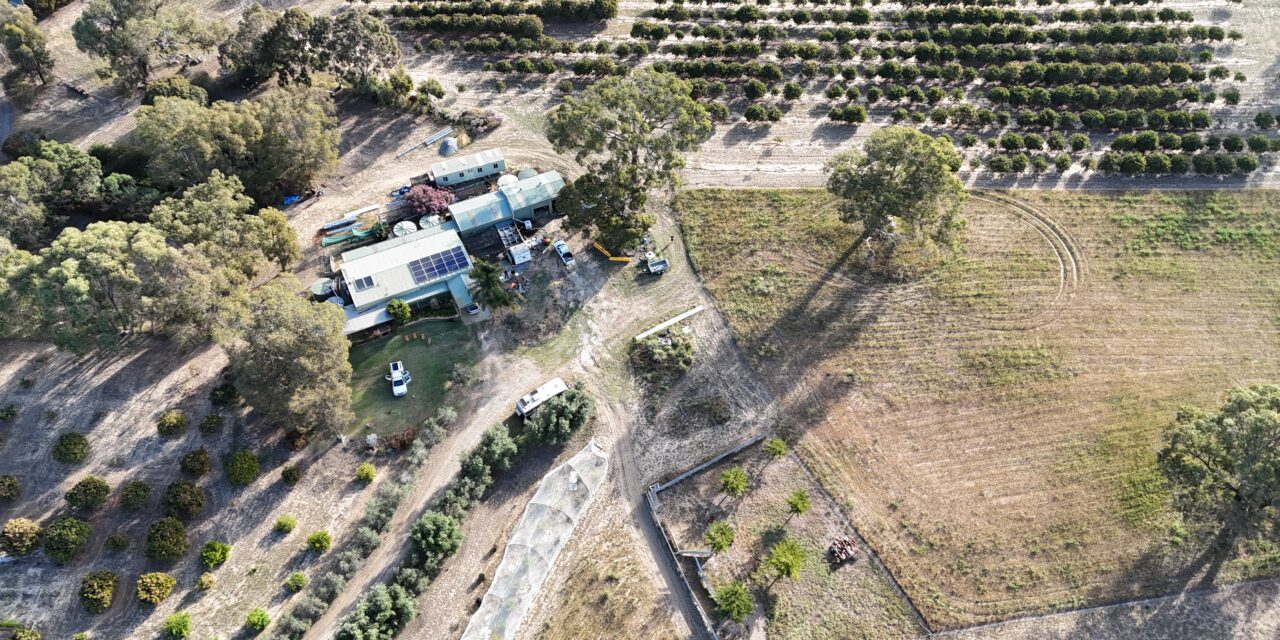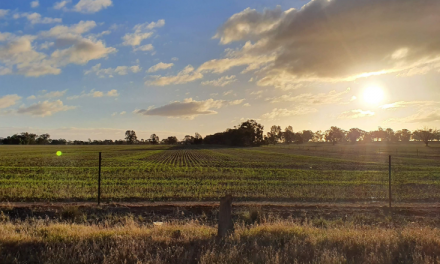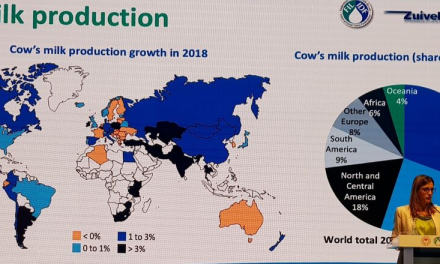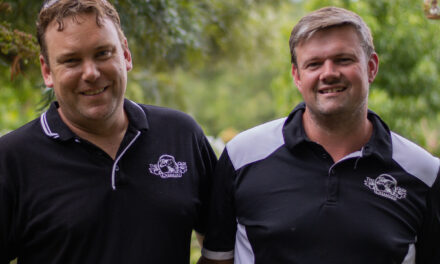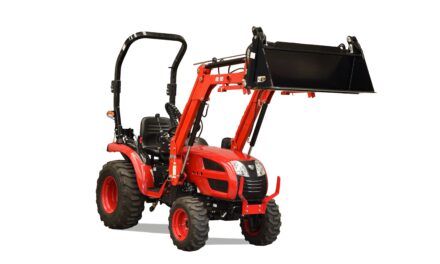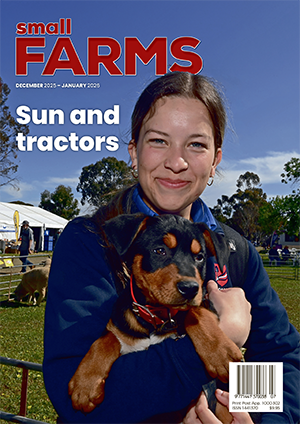Sustainability on a small farm — is it feasible not only in terms of financial sustainability but also in terms of being at least carbon neutral or even carbon positive? Is it possible with small farm financial constraints to achieve soil improvement with positive on-farm carbon practices? Is it possible to make a small farm financially viable and be a good farm citizen?
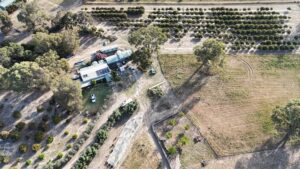
Cayden Jack Farm aerial photo of the main orchard and house and workshop.
The farm’s history to date
Cayden Jack Farm (CJF) is 10 hectares at Wanerie, between Lancelin and Gingin, in Western Australia, and was purchased in 2015.
The orchard consisted of around 300 mango trees and 50 olive trees, all of which had not been watered or fertilised for several years resulting in a diseased and poor condition.
The property had a water licence of 18,150 kilolitres (kL) and an antiquated irrigation system with three 20,000-litre storage tanks and a borehole equipped with an old pump around 40m deep.
The farm equipment was old and in poor condition. The tractor shed was small and totally inadequate.
The first task on taking over the property was to apply around 500 grams of horticultural special fertiliser and establish a watering program. Spray for black spot, control the grass between rows and spray to control the weeds. This maintenance regime continues to today.
Within the first year the water storage capacity was doubled to six 20,000-litre tanks, a new larger shed and new equipment including new tractor and implements, new borehole pump and irrigation pump as well as other improvements, the cost of which was in excess of $100,000.
Carbon sequestration: The Wood Pile
During the year, most farmers accumulate timber from fallen branches, dead or unwanted fruit trees and/or pruning activities and by May, the timber pile can mount up and once the restriction on fires has been called off a large bonfire is the usual result.
This practice, however, results in the release of carbon dioxide (CO2) into the atmosphere — an undesirable action.
To ameliorate the situation, a solution would be to chip the timber and return it to the soil as a mulch, however the economics of this needs to be studied to ensure the energy expended and the cost are beneficial to the farmer if the practice of burning is to be avoided.
A study of the financial costs and carbon costs are the result of consulting with local tree lopping contractors, machinery manufacturers and extensive research online.
The cost of mobilisation to CJF, with the equipment and crew in terms of diesel based on an Isuzu model FRR, is 16 litres for a round trip of 80km and the consumption of fuel for the chipper for an eight-hour day’s work of 100 litres.
The total of 116 litres of diesel represents the release of 310.88kg of CO2 into the atmosphere. (One litre of diesel creates 2.68kg of CO2.)
It is estimated that in an eight-hour day production of wood chip would be around 30 cubic metres and would result in about 1600kg of CO2 to be sequestrated into the soil.
From a financial position, the cost of a tree lopping contractor would be of the order of $4000/day and the resultant wood chip of 30 cubic metres works out at $133.33/cubic metre.
The weight of wood chip is around 350kg/cubic metre, therefore 30 cubic metres represents a total of 10.5 ton of timber.
It would behove a farmer to ensure his timber stack was organised and of sufficient quantity to achieve an economy of scale considering the investment.
The result in terms of CO2 sequestration is excellent, however, the cost of the resultant mulch is marginal.
Pruning the orchard
Annually, the pruning of the mango trees, the olive trees and a variety of other fruit trees results in a considerable quantity of green vegetation and woody stems of up to 25mm diameter.
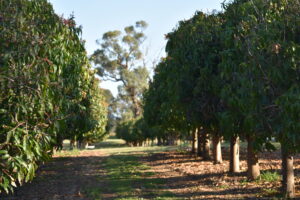
Cayden Jack Farm Photo of 450 manga tree orchard pruned and ready for the new season.
It is difficult to estimate the quantity as it depends on the year’s growth to a large extent. However, in an orchard of around 600 trees, it is feasible for each tree to produce from 5kg to 20kg of pruning material.
The practice at CJF is to use a flail mower on the tractor three-point linkage to mulch the plant matter in the rows beside the trees rather than the old method of raking it up and burning the plant matter.
The only reason to revert to the old slash and burn method would be to remove diseased plant matter.
Preparing the silage fields
CJF has an area of around two hectares used for the winter production of silage for the sheep.
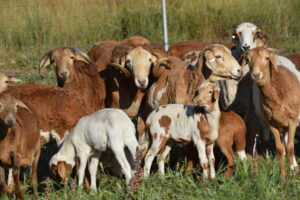
Cayden Jack Farms Flock of Damara Sheep. (2)
The final winter growth of silage comes to an end around the end of October and the sheep paddock is devoid of grass by the end of the year.
The sheep are at this point rotated through the two hectare silage paddock for a period until the rains are reliable in May, at which point the paddock is prepared for seeding of silage.
The preparation includes the use of the flail mower to slash the remaining stubble so it lies on top of the soil. A light spreading of super phosphate is applied (around 50kg/ha) and the soil is prepared for seeding by the use of an offset disc harrow set to penetrate the soil 150mm to incorporate the remaining plant matter into the soil to sequestrate the carbon and provide humus to the top layer of soil which in turn helps retain soil moisture and provides a thermal element during the seed propagation.
CJF does not have a wind issue and the soil preparation is commenced only after the first substantial rainfall event has occurred in order to prevent soil degradation. I call this ‘lo-till’ as opposed to ‘no -till’.
Fertiliser regime
Before you can consider any fertiliser you need to know your soil type.
On CJF we have deep sandy soil, pH level around 6.9, deficient in nutrients including N, P, K and trace elements.
This scenario precludes the use of fertigation because as soon as you mobilise the fertiliser in water it passes through into the groundwater below and will eventually cause blue algae bloom in the waterways.
A further consideration to efficient use of fertiliser is the orchard trees cultivated.
At CJF, they are largely mango trees which have a large tap root 2m to 6m deep, which means the fertiliser should be placed near the trunk of the tree. This is reinforced by the irrigation system used, which has 1.0 round sprinklers placed close to the trunk.
Based on the above, on CJF we use slow-release granular fertiliser called ‘Horticultural Special’, which has a full range of elements including all trace elements.
The trees are fertilised twice a year with about 500 grams on each occasion. The fertiliser in placed manually at each tree’s trunk twice a year after fruiting in May and November.
This regime has proved successful over the past six years.

